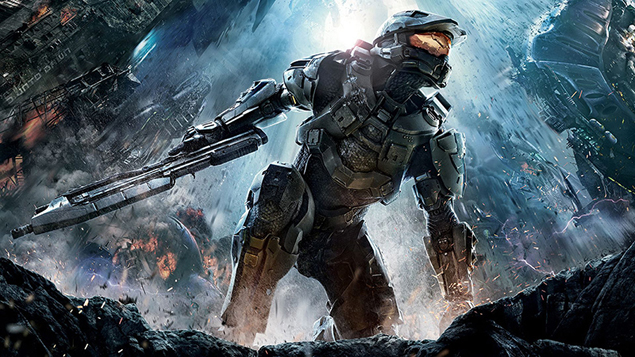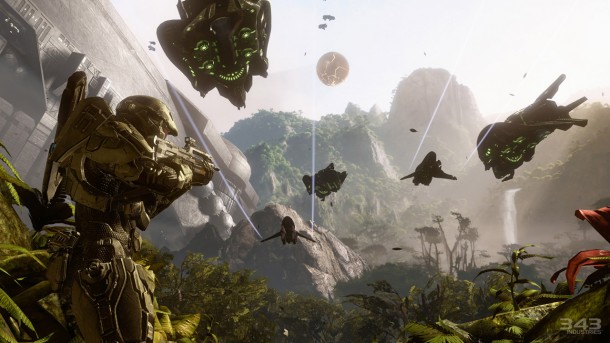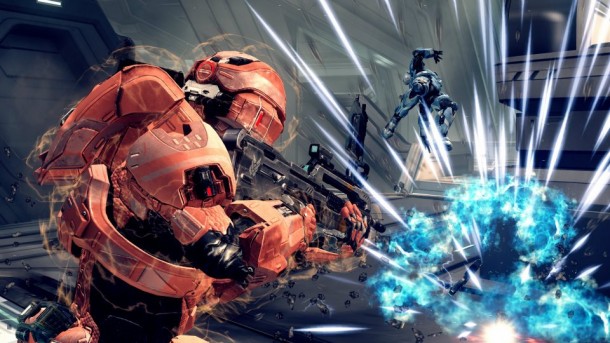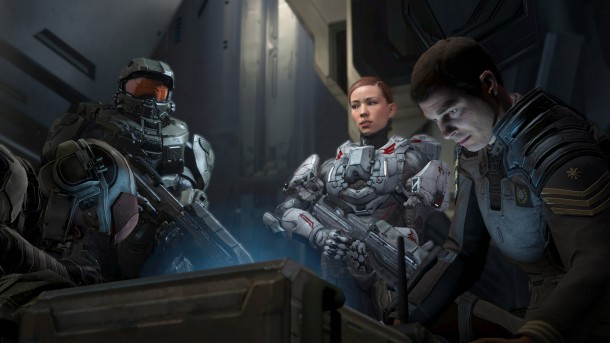Breathe easy, Halo 4 is a faithful entry in the franchise started by Bungie 11 years ago. From the strategic firefights, to the one-button vehicle flipping, it’s all there, just like you wanted. 343 Industries revitalizes the franchise with the kind of aplomb latter entries in the series lost. But Halo 4 lacks ambition. Despite the staunch recreation of Bungie’s work, 343 Industries misses its chance to make its mark on the series.
Halo 4 is all about consistency. It preserves the underlying Halo campaign experience, often retreading specific scenarios, and updates the aesthetics without altering what’s defined Halo’s look in the past. 343 Industries proves they can modernize the combination of metallic architecture and grand, Earthly environments to great effect. The game looks stunning, both in graphical fidelity, and art direction. The Forerunner planet, Requiem, similar to the Halo rings in previous games, splits its environment between familiar deserts and rocky plains with brightly lit alien structures that feel alive, shifting and interlocking as you dart around during battle. In the latter stages, it almost feels like a Halo-Tron crossover with harsh, contrasting blues and oranges. But underneath the sheen lies familiar territory if you’ve played a Halo game before.
On one mission, you’ll drive a Scorpion tank across a bridge, on another, you’ll move through what seems like an empty room, on a slow moving platform, as enemies appear to halt your progress. There’s even a blatant reference to the original game’s ending. It’s as if 343 Industries were forced to follow a checklist of gameplay scenarios from the previous games. All the new weapons and armor abilities can’t help from making these moments feel rote and uninspired.
Thankfully, the series’ signature combat returns to break up the monotony. The game is a little speedier with a permanent sprint button, but you’ll still work through enemy encounters like puzzles, and it’s as satisfying as ever. The Covenant haven’t changed their tactics, either. Grunts and Jackals litter the battlefield with the Elites bringing up the rear. They’re a problem you’ve solved before, and pose little threat once Halo 4’s new race of enemies is introduced.
Those new enemies, the Prometheans, are tough to crack at first. They’re more resilient and aggressive than the Covenant, and if you aren’t careful, they’ll soak up your ammo and overwhelm you. Once you develop a routine, however, they become considerably easier to deal with.
Playing on Normal, they were the first Halo enemies to offer a real challenge since the Brutes in Halo 3. And just as you start to get comfortable, the game throws more at you, forcing you to utilize different weapon combinations when your favorites dry up.
The new Promethean weapons mimic much of Halo 4’s execution: form over function. They fit into the usual gun archetypes we see in every shooter with a few quirks. There’s a shotgun with bullets that ricochet, a rifle that shoots in four-shot bursts and single-shot when zoomed in, a rapid-firing assault rifle, a mid-range pistol, a rocket launcher, and a sniper rifle. While it’s fun to watch them disassemble and reassemble with an alien flair, their use never feels distinctly different than the rest of the game’s weapons.
When you’re not shooting, Halo 4 adds considerable flavor to the cutscenes. The Halo series has gradually found its place when it came to humanizing its characters and story with each game. Halo 4 addresses those problems head-on with some of the most detailed facial animation and emotionally-fueled voice acting this year. Characters communicate through the subtleties of conversation, with impressive use of expressions and cadence to match the scenes. It’s the kind of restraint seen in 2010’s Enslaved: Odyssey to the West where its characters said more when they weren’t talking. The Master Chief and Cortana have a history, and the dialogue handles the weight well, finding a balance between serious and light. It’s clear Halo 4 has a story to tell, and it wants you to take it seriously.
343 Industries shows a similar mastery of the Halo universe in the sound design and art direction. In the past, Halo’s weapons have sounded chunky, and muted. Halo 4 goes in a different direction. You’ll want to pick up every weapon just to hear how it sounds. Each one clicks, hisses, and pops with amazing clarity. But fighting within Halo’s large-scale arenas is just as crisp to hear as it is to see.
The artists understand Halo’s art style and use it to stage dramatic environments to drop you into. There’s a level that begins overlooking the charred and ravaged remains of several ships. The ships are layered before you like a pyramid of wreckage with smoke billowing out over the area. It floods the scene with a thick, charcoal haze as you survey the destruction. Halo 4 brings a flair to the construction of its set pieces only a team that understands the material can pull off, and it looks stunning while doing it.
Where the campaign takes what the Halo series started and adds to it, the multiplayer shamelessly adopts what the Call of Duty series has banked on since the first Modern Warfare. Halo: Reach was already halfway there with armor abilities, and Halo 4 completes the transition with its version of perks and deeper customizable loadouts. Like Call of Duty, you can mix and match weapons, grenades, and perks, like faster recharging shields, more ammo, and quicker reloads. It doesn’t take long until you’ve got a comfortable loadout that fits your playstyle. Each match earns you points to spend on items that you’ve unlocked while leveling up. The problem is, you never know what items will be unlocked next, forcing you to save a few points in case something good is coming next. If you’re a Halo multiplayer veteran, having to go through the process of unlocking items that used to be there from the start is a minor annoyance, but it doesn’t take long before you’re back into the swing of things.
That said, the multiplayer is largely unchanged. The fear of finding players who have unlocked better weapons and equipment through Halo 4’s new progression system before you isn’t a factor; thanks to Halo’s combat puzzle formula, there’s always a counter. After earning a handful of kills, you gain the ability to call in ordinance, which grants useful tools like a overshields, temporary damage boosts, or powerful weapons not available from the start. If you’re lucky, weapons like the SAW will drop, letting you quickly alter the balance, and forcing players to try and take you out from afar. It adds an exciting, random element to the matches that Halo hasn’t been able to capture before.
When you’ve had your fill of killing your fellow Spartans, you can work together in Halo 4’s new Spartan Ops mode. Spartan Ops is split into chapters, each containing five scenarios set on maps pulled from the campaign. You can play through them by yourself, with friends, or through matchmaking. It’s a neat idea, but it does nothing as different as Call of Duty’s Spec Ops mode. Instead, bits of narrative spew out over your radio as you work your way through maps with various enemy encounters. The first batch is included on the disc, and its value depends on how much you like Halo’s combat. Other than pressing a few buttons and holding a few positions, the missiosn don’t stray far from what can be found in the campaign. It feels like a replacement for the wave-based Firefight mode, but with concessions for narrative that make the gameplay less interesting. It’s a disappointing experiment so far. Hopefully, upcoming chapters will change that.
Like Spartan Ops, Halo 4 seems afraid of iterating on Bungie’s formula, and what’s presented as being new, isn’t really new. Halo 4 is clearly the product of a studio that loves the Halo franchise. Every second of the experience feels familiar, and modernized in the right ways. It’s the ultimate Halo game. But it relies too heavily on expectations. It’s over by the time it delivers everything a Halo game should have, and it loses precious time to move the series forward.
This review is based on a copy of the game purchased by the reviewer.






No Comments